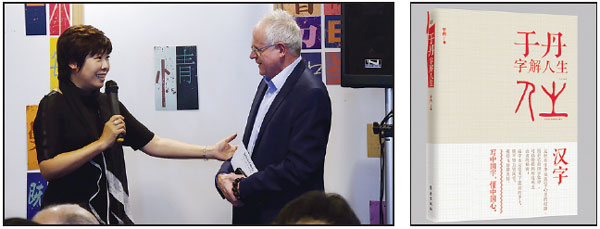Using Chinese characters to promote culture through imagery
|
Left: Yu Dan speaks to a French official during the event about learning Chinese characters at the headquarters of UNESCO in Paris in October. Right: Yu's new book Yu Dan Interprets Life Using Chinese Characters. Photos Provided to China Daily |
Hanzi (Chinese characters) are not difficult to understand and learn if studied from the aesthetic perspective of pictographs and as a carrier of Chinese culture, says Yu Dan, a spokeswoman for traditional Chinese culture and professor at Beijing Normal University.
Earlier this year, she published Yu Dan Zijie Rensheng (Yu Dan Interprets Life Using Chinese Characters).
"Hanzi is a good medium for us to tell Chinese stories," she says.
In the book, Yu combines the evolution of hanzi with that of Chinese society to interpret the meaning of hanzi and the cultural connotations.
At the end of October, Yu hosted a cultural event at the headquarters of the United Nations Educational, Scientific and Cultural Organization in Paris, which focused on how to use hanzi, especially through design, to explore their external and internal beauty.
The activity was co-hosted by the Beijing Institute of Culture Innovation and Communication and Dongdao Creative Branding Group.
At the event, ambassadors and senior officials from UNESCO, Greece and other countries played a game to piece two components together to form a Chinese character, with every character having the heart component.
"This year, we focused on the hanzi component xin (heart)," says Yu, 50.
Xin covers many thoughts including mercy (cibei) and will (yizhi). They come from the heart because the characters in these words have heart as the base, she says.
"It might be difficult to talk about Taoism and Confucianism, but if you analyze a Chinese character, you will find it's like a picture, a pattern, referring to a certain thought in Taoism and Confucianism," she says.
For instance, in ancient China, the father was seen as the leader of a big family. The character fu (father) looks like the cross of weapons or fans held by a guard of honor, symbolizing the power a father has in a family. Characters related to power, such as ba (father in spoken Chinese) and ye (grandfather), have the component fu.
"The Chinese say that if a child has no breeding, it is the father's fault because he sets the rules for the family, defining how it should behave," she says.
"In hanzi you can also see the profound influence of agriculture on Chinese culture," she says,
As an agricultural country, Chinese society has a stable family pattern - men working outside to provide food for the family and women working at home to cook and keep the house clean.
Therefore, the character nan (man) has a tian (field) and a li (physical strength). "A man is a person who uses his strength in a field," she says. The character fu (married woman) looks like a woman holding a broom, she says.
The event was a great success, Yu says. "By the end, we had spent double the time we had originally planned and every participant worked out his own characters. We also invited a calligrapher to write the characters for them to take back home," she says.
At the end of the event, the Beauty of the Chinese Character global design contest was launched.
Students or young teachers of design, between 18 and 44 years old, from all over the world are welcome to compete in the contest.
"We are talking about introducing our culture to the world, but we overlook hanzi, which is a good carrier. Through the competition, we hope that more young people around the world can create products for daily use like cups, scarves or stationery that are injected with hanzi elements," she says.
"At the next hanzi event, we will focus on another component baogaitou (family), and we are looking forward to seeing many products that have been created in the past year," she says.
yangyang@chinadaily.com.cn



















